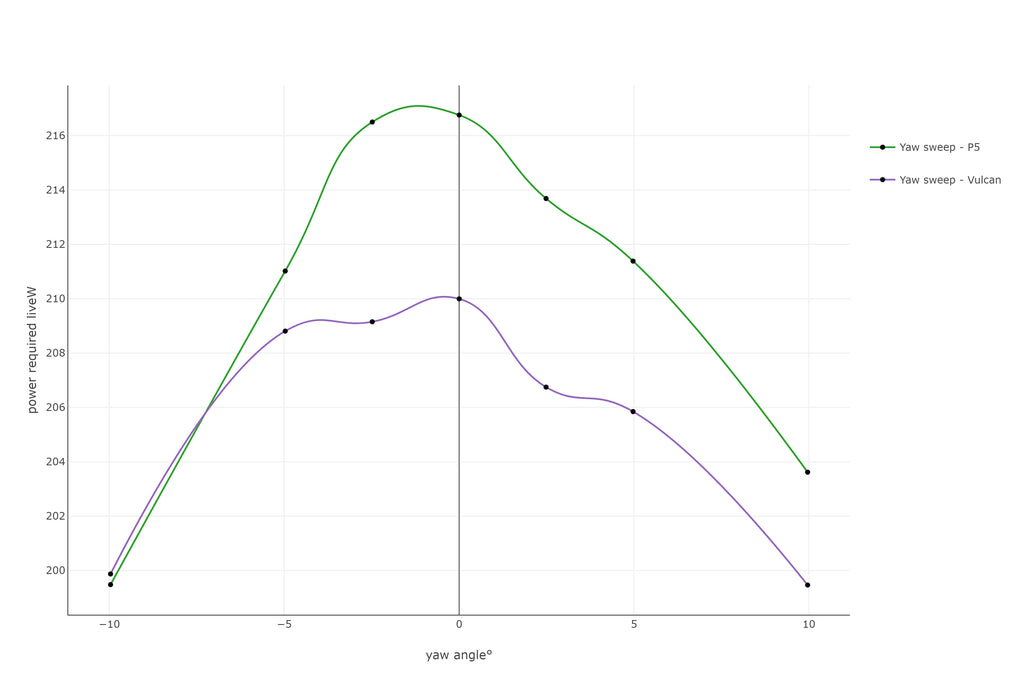REAP Vulcan vs. Cervelo P5
Jan 02, 2024
Taking a trip to the wind tunnel to finally put all of your hard work to the test brings about odd feelings. You're split. One part of you is buzzing with excitement to put it to the test and see how the bike performs. The other half however, less so. The other half is thinking, 'what if we got this bit wrong?' or, 'what if that bit isn't quite the right shape?' Ultimately, you've done all you can but that's just who we are, obsessed with the details and always trying to calculate how to be that bit better.
With the test protocol decided, we started our testing with the Cervelo P5 in place on the rig to establish our baseline. The mark to beat. All tests today would be performed with a rider on the bike. It's only certain instances where testing without a rider holds value, but in most cases you need to know the bike is quick with a rider on board.
We performed a number of runs on the P5 to ascertain drag values across a range of yaw angles (-10, -5, -2.5, 0, 2.5, 5, 10 degrees) at 40 kmph and a range of wind speeds at 0 degrees yaw from 30 - 50 kmph.

We performed each yaw and speed sweep twice to test the efficacy of the data. I.e. if one is significantly different from the other of that same run, we'd perform this again to establish which is the anomaly. This means we can be more confident in the accuracy of the data.
With the P5 tested, next up, the Vulcan.
After switching the bikes over we performed exactly the same test runs on the Vulcan as we did on the P5 just before. It's important to say that both bikes were set up as closely as possible to each other in terms of position. On top of that, when cycling in the tunnel, the rider is able to see a display that shows a trace outline of the baseline test so they have a target of where to keep their hands, head, shoulders etc. so they're in a position as close to that baseline as possible. Nothing is really left to chance here, the team at Silverstone Sports Engineering Hub are top class and ensure the data they produce is as fair and accurate as possible for the riders.

The results were in and just like that all those doubts that plague your mind dissipate. One of these bikes is an Olympic Champion, a Tour de France winner and a multiple-Ironman Champion. The other one tested even faster. Across the yaw speed, with the two runs averaged out, the Vulcan tested over 2W faster than the Cervelo P5. That's a little over 30 seconds over an Ironman bike leg. Across the speed sweep, Vulcan ranged from 2W faster at 30 kmph to nearly 7W faster at 50 kmph.

This testing is just an indication of the aerodynamic performance of these two bikes but to consistently perform faster than one of the most successful bikes in triathlon is a great day at REAP.
One of the even bigger benefits of our Vulcan triathlon bike is its beam design. It isn't solely for aerodynamics as many people suspect. The beam allows the vibrations from the road to be absorbed and dissipated across the frame as opposed to being transferred directly to the saddle and into the riders lower back and glutes. We're yet to put a number on the benefit of this but this particular ride quality is evident when you ride a Vulcan. This bike-to-run approach coupled with its proven aerodynamic prowess puts Vulcan at the top of the tri bike rankings.
If you want to hear more about the Vulcan or want to know when there are demo bikes available to test ride, please sign up below. For anybody interested in seeing the full suite of data, please email us at info@reapbikes.com and we'll help send you a .csv file with all run data contained.


